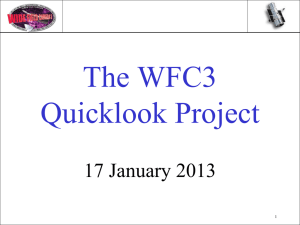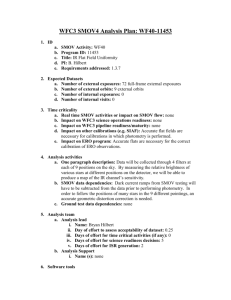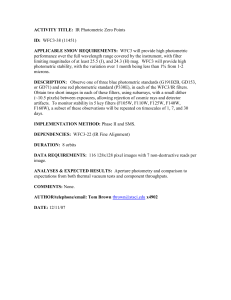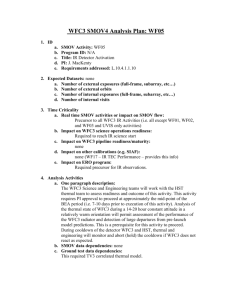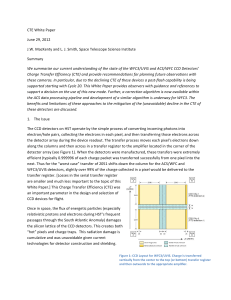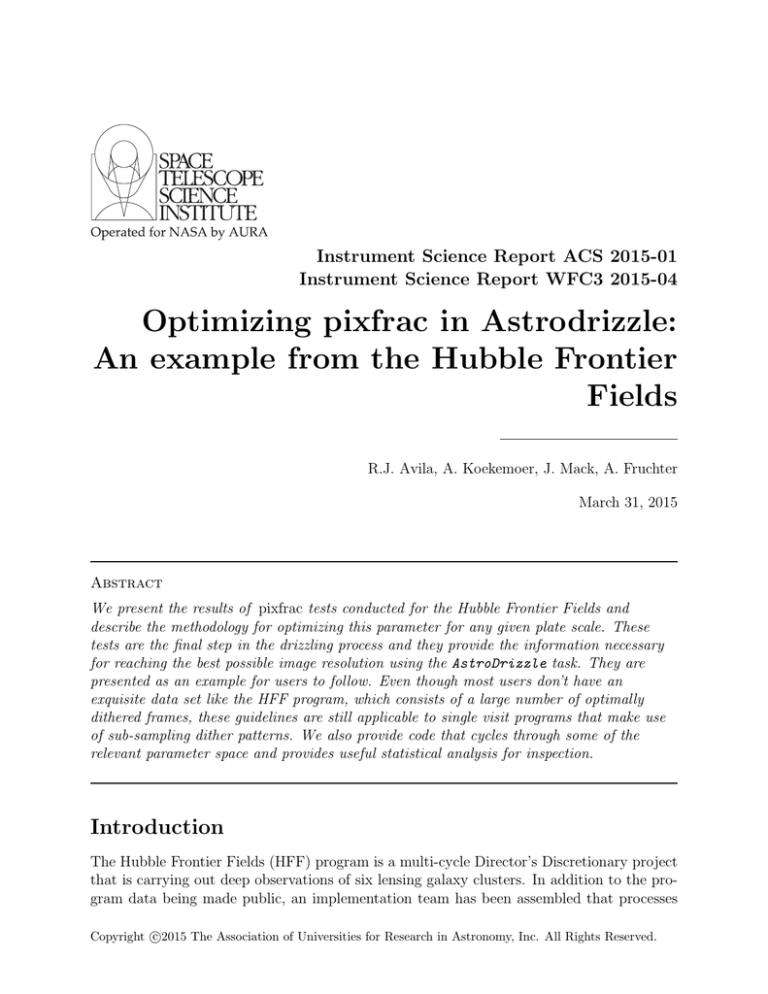
Instrument Science Report ACS 2015-01
Instrument Science Report WFC3 2015-04
Optimizing pixfrac in Astrodrizzle:
An example from the Hubble Frontier
Fields
R.J. Avila, A. Koekemoer, J. Mack, A. Fruchter
March 31, 2015
Abstract
We present the results of pixfrac tests conducted for the Hubble Frontier Fields and
describe the methodology for optimizing this parameter for any given plate scale. These
tests are the final step in the drizzling process and they provide the information necessary
for reaching the best possible image resolution using the AstroDrizzle task. They are
presented as an example for users to follow. Even though most users don’t have an
exquisite data set like the HFF program, which consists of a large number of optimally
dithered frames, these guidelines are still applicable to single visit programs that make use
of sub-sampling dither patterns. We also provide code that cycles through some of the
relevant parameter space and provides useful statistical analysis for inspection.
Introduction
The Hubble Frontier Fields (HFF) program is a multi-cycle Director’s Discretionary project
that is carrying out deep observations of six lensing galaxy clusters. In addition to the program data being made public, an implementation team has been assembled that processes
c
Copyright 2015
The Association of Universities for Research in Astronomy, Inc. All Rights Reserved.
the data and publishes high level science products (HLSP) on a regular basis. In order to
provide the astronomical community with products that have the best possible image resolution, the parameters in the AstroDrizzle task, which is used to make the final products,
need to be carefully tuned for a data set of this size.
Drizzle algorithm
AstroDrizzle uses the drizzling algorithm (Fruchter and Hook, 2002) to combine images.
When the observations have been optimally dithered, this algorithm has the capability to
improve the pixel sampling of the final combined image with respect to the input frames,
which are undersampled for all HST instruments. This is accomplished by “shrinking” the
input pixels before dropping them onto the sub-sampled output image. The shrunken pixels,
also called “drops”, rain down on the sub-sampled output frame where each shrunken pixel
is averaged into an output pixel, with a weight proportional to the area of overlap between
the “drop” and the sub-sampled output grid. The final products have sharper and narrower
PSFs than the original input images.
The particular parameters that control the sampling of the final image are final scale
and final pixfrac (or simply scale and pixfrac). The scale parameter was determined before
processing to meet the scientific requirements of the project (more details are provided in
the Method section). The pixfrac parameter has to be empirically derived for each data set.
If pixfrac is too small, there could be data missing in some of the pixels of the output frame,
caused by pixels that get thrown out in individual frames (e.g., CRs, hot pixels, etc) and
the uneven coverage from image distortion. If the value is too big then the input pixels will
overlap, causing correlated noise and blurring the output image. The appropriate value for
pixfrac depends on the number of input images and the dither pattern, and therefore must
be tuned for each data set. As recommended in the “Dither Handbook” (Koekemoer et al.,
2002) and the “Drizzlepac Handbook” (Gonzaga et al., 2012), statistics performed on the
drizzled weight image should yield a RMS/median value of no more than 0.2. This threshold
controls the trade-off between improving image resolution versus increasing background noise
due to pixel resampling.
In this report we describe the process of determining the optimal value for pixfrac, and
show results from our tests. Since the observing setup is important to this process, specifically the dither pattern used, we provide a brief description of how the observations were
conducted. Finally, we provide the scripts written for these tests so that observers can use
them on their own HST images.
Data
The HFF campaign is observing six lensing galaxy clusters, using seven filters across two
instruments (ACS/WFC: F435W, F606W, F814W and WFC3/IR: F105W, F125W, F140W,
F160W). Each cluster is observed with one of the instruments on the cluster and the other
on a blank, parallel field. Approximately six months later, the cluster is observed again with
the position of the instruments on the sky switched. Each epoch of observations requires 70
orbits, for a total of 140 orbits per cluster. Koekemoer et al. (2013) contains a full description
2
Camera
Filter
Orbits
Nimg
Exptime (s)
ACS/WFC
ACS/WFC
ACS/WFC
WFC3/IR
WFC3/IR
WFC3/IR
WFC3/IR
F435W
F606W
F814W
F105W
F125W
F140W
F160W
18
10
42
24
12
10
24
36
20
84
48
24
20
48
46414.
25430.
107766.
67696.
33048.
28140.
66896.
Table 1: Observation log for the data set used in these tests. All the data comes from PID 13495.
of the observing setup and a complete log of the data.
The first cluster for which the first epoch of observations was completed was Abell 2744
(Program ID 13495; PI Lotz, J.). There is extant HST data for this cluster taken by other
programs (PID: 11689, 13386, 13389) which is included in the final HLSP mosaic released
by the implementation team. Because those images were taken with different offsets and
orientations, and because all the clusters in the HFF program will be observed with an
identical setup, we chose not to include the extant data in these tests. We only used the
images included in the HFF program. Table 1 contains a summary of the data sets.
Dither pattern
An important aspect of drizzling images to improve the resolution is that the observations
must be dithered. Dithering is the process where the telescope is moved in between exposures
so that the image is sampled by different parts of the detector each time. This makes it
possible to eliminate detector and observational artifacts like hot and warm pixels, bad
columns, flat field anomalies, cosmic rays (CRs), etc. Additionally, if the dither pattern
includes sub-pixel shifts, the PSF can be well sampled and reconstructed via the drizzle
process (Fruchter and Hook, 2002).
HFF observations employed a custom dither pattern that takes into account artifacts
in both WFC3/IR and ACS/WFC detectors. Each of the two-orbit HFF visits comprises
four half-orbit exposures. Within each of the two orbits, the telescope has a compact (∼few
WFC3/IR pixels) dither with half-integer pixel phase offsets. Between the two orbits, there
is a much larger offset of ∼5” offset to step over the WFC3/IR blobs (Pirzkal et al., 2010;
Pirzkal and Hilbert, 2012; McCullough et al., 2014) and the ACS/WFC chip gap. This large
step eliminates any large holes in the final mosaic. The targeting of the 5–21 visits for any
particular filter is modulated by an additional compact (<6 WFC3/IR pixels) inter-visit
dither. The inter-visit pattern is designed to maximally sample WFC3/IR pixel phase and
to ensure that no two dithers in the entire pattern are landing within one WFC3/IR pixel
of one another.
Figure 1 shows the dither pattern and the pixel phase of the F140W filter. The dither
is simply the commanded offset (in arcseconds) for each image. The pixel phase shows the
amount of sub-sampling attained with these observations. To estimate these values, we
found the sky position of the reference pixel for one of the images in this filter. For the
3
Figure 1: The left hand plot shows the dither pattern used for F140W observations of the HFF program.
The Postarg header keyword describes the size of the telescope offset in arcseconds. The right shows the pixel
phase for this filter. The pixel phase shows how much sub-pixel sampling was achieved in these observations.
rest of the images we then computed the pixel value of that sky position using the header
world coordinate system. The phase is the fractional part of that pixel position. Since these
images were previously aligned via the tweakreg task, this measurement of the realized
dither pattern is considerably more accurate than trusting the commanded offsetting across
many separate HST visits.
Method
To conduct these tests, we explored the parameter space of the relevant AstroDrizzle
options. These options include pre-determined values for the plate scale, weighting scheme,
and drizzle kernels. These were pre-determined because of the scientific considerations of the
HFF data. The one free parameter in these tests is the pixfrac option. Here we explain each
of the options. The name of the description is how the options appear in the AstroDrizzle
task and the values in brackets are the values used.
final scale {30, 60 mas} This controls the plate scale of the output images. The larger
plate scale gives good sampling in IR images, but under-samples ACS images. The
smaller plate scale critically samples ACS images and over-samples IR images.
final kernel {square, gaussian} This parameter describes the form of the kernel function
used to drizzle flux in the output images. The gaussian kernel produces well behaved
PSFs and is usually used for point source photometry. Square is the classic kernel.
final weight {EXP, IVM} This instructs the drizzle task what weighting scheme to use
when drizzling images. The EXP scheme weights each pixel by the exposure time.
This scheme is useful when the objects of interest are dominated by Poisson noise.
4
The IVM scheme weights each image by an inverse variance map, which is good for
objects dominated by sky background and read noise.
final pixfrac {0.1 - 1.0} This is the free parameter for these tests. It tells drizzle by how
much to shrink the input pixels before dropping them into the output image. In general,
using a large pixfrac increases correlated noise and blurs the image. Using too small
of a value causes increased variation in the weight image, blocky PSFs, and possibly
holes of missing data in the final image.
For these tests we used the FLT/FLC images that came out of the HFF pipeline (Koekemoer et al., 2013). This pipeline updates the world coordinate system in the header of the
images with the best alignment solution. They are also run through the AstroDrizzle to
detect and flag cosmic rays and other image artifacts. The data quality arrays (DQ) of these
FLT/FLC images contain this information in the form of masks. This facilitates the pixfrac
tests because one does not need to run through the entire Astrodrizzle process for every
permutation of the parameter space, but instead only run the final drizzle step to optimize
the relevant parameters. One must be careful to conserve the CR flags in the DQ arrays in
each subsequent run. This is done by setting ‘resetbits=0’ so that the flags are retained in
each run.
We drizzled each set of images using all the permutations of the options described above.
We wrote a python script that facilitates this process by running through the range of pixfrac
values and automatically analyzing the drizzle products. This script (pixfrac tester.py)
can be downloaded from the DrizzlePac website1 .
Results
For the sake of this discussion, we will show the result for only one case; the WFC3/IR
F140W filter with EXP weighting, square kernel, and 30mas pixels. We chose this as an
example because it is the data set where the pixfrac optimization will make the biggest
difference: it is an undersampled PSF, the stack contains the fewest exposures, and it is the
smallest of the output plate scales. The full set of results for all permutations can be found
in the appendix of this document.
We used the AstroDrizzle products to measure statistics of the weight images. The
Drizzlepac Handbook (Gonzaga et al., 2012) says that one should use a large area of the
weight image and measure the RMS/median of that section. One should take care to use the
same region in the weight image as the region where the object of interest is located in the
science image. If one is using the entire image for scientific analysis, then one should measure
the statistics of the weight image where there is more variance. This statistic should remain
below ∼0.2. This threshold controls the trade-off between improving image resolution versus
increasing background noise due to pixel resampling. We selected a 500×500 pixel region of
the weight image that avoided blobs (in IR products) and bad columns (in ACS products)
that could contaminate the measurements. Figure 2 shows how the RMS/median statistic
varies with changing pixfrac. The plot indicates that one should choose pixf rac = 0.7.
1
http://drizzlepac.stsci.edu
5
Figure 2: Example of how RMS/median varies with changing pixfrac. The dashed red line marks the
threshold recommended in the DrizzlePac Handbook.
Figure 3: The contours of a star from the example dataset. On the left the pixfrac was 0.2, where the
RMS/median statistic exceeds the recommended value. The contours looks blocky and uneven. On the right
is the same star with pixf rac = 0.7, the value selected.
6
Figure 4: A 27”×27” section of a poor product, where pixfrac was set to 0.2. The whites points are output
pixels where there was not data. They were marked with very high values so that they could be easily seen
in this image. The clusters of points are locations where there are IR blobs in the input images, so half of
the input pixels have been flagged and there is insufficient data at this pixfrac setting. The more evenly set
of points on the right side of the image is caused by geometric distortion. Close to the edges of an image
the pixels are distorted enough to cause uneven filling with such a low pixfrac value.
The RMS/median statistic is not the only criteria used to choose a value for pixfrac.
We also inspected the AstroDrizzle science products. One should ensure that the PSFs of
stars have not been degraded. If pixfrac is too small the contours of stars can appear blocky
instead of round (figure 3). Another problem that can arise if pixfrac is too small is that the
image can contain a large number of empty pixels where there was no information (figure 4).
We checked the image with pixf rac = 0.7 and found that there were no defects in the
contours of stars and no problems of missing data. This confirmed that the value indicated
by the RMS/median statistic was good, and we used that for this data set.
The rest of the datasets required the same amount of scrutiny. We found that, in some
cases, the value of pixfrac obtained from the RMS/median statistic was not adequate due to
blocky PSFs, and therefore had to be made larger. Additionally, we tried to maintain some
uniformity, for example by using the same value for all the ACS frames. Table 2 summarizes
the pixfrac values to be used for this and all subsequent data sets in the HFF program.
There is further information to be gained from the aggregate results. For a given case, the
results between EXP and IVM weight maps are nearly identical. IVM weight maps contain
information about the flat field, which is the main source of the difference. Additionally, the
results show that pixfrac can be pushed to smaller values by using the square kernel instead
of the gaussian kernel. This is because the square kernel distributes light more evenly on
the output grid, therefore reducing the variance of the weight map.
7
Instrument
Filter
Drizzle
kernel
Nimg
Pixfrac
0.03”/pix
Pixfrac
0.06”/pix
ACS/WFC
ACS/WFC
ACS/WFC
WFC3/IR
WFC3/IR
WFC3/IR
WFC3/IR
F435W
F606W
F814W
F105W
F125W
F140W
F160W
square
square
square
square
square
square
square
36
20
84
48
24
20
48
0.7
0.7
0.7
0.6
0.7
0.7
0.6
0.6
0.6
0.6
0.5
0.6
0.6
0.5
Table 2: The final results from testing. The listed pixfrac values will be used in all HFF data.
Discussion
We presented an example of the recommended method for optimizing the pixfrac parameter
in the AstroDrizzle task. Even though there is no cookbook or straight forward set of rules
that users can follow to accomplish this task, the guidelines we show here can be applied even
to the simplest observations, as long as they make use of dither patterns that sub-sample
the PSF.
The code we provide can be used to make drizzled products with different parameters, or
should at least be a good starting point for users to create their own pipeline. It would still
be difficult to completely automate the process of selecting the right value for pixfrac, since
visual inspection is still required even when statistics indicate a desired value. The vagaries
of real data do not allow it and therefore a little bit of judgement still comes into play.
Acknowledgements
We would like to thank Norman Grogin for providing a description of the dither pattern used
in this program. We would like to thank Linda Smith, Heather Gunning, Ray Lucas, and
David Borncamp for useful comments. This research made use of Astropy, a communitydeveloped core Python package for Astronomy (Astropy Collaboration et al., 2013).
References
Astropy Collaboration, T. P. Robitaille, E. J. Tollerud, P. Greenfield, M. Droettboom,
E. Bray, T. Aldcroft, M. Davis, A. Ginsburg, A. M. Price-Whelan, W. E. Kerzendorf,
A. Conley, N. Crighton, K. Barbary, D. Muna, H. Ferguson, F. Grollier, M. M. Parikh,
P. H. Nair, H. M. Unther, C. Deil, J. Woillez, S. Conseil, R. Kramer, J. E. H. Turner,
L. Singer, R. Fox, B. A. Weaver, V. Zabalza, Z. I. Edwards, K. Azalee Bostroem, D. J.
Burke, A. R. Casey, S. M. Crawford, N. Dencheva, J. Ely, T. Jenness, K. Labrie, P. L.
Lim, F. Pierfederici, A. Pontzen, A. Ptak, B. Refsdal, M. Servillat, and O. Streicher. Astropy: A community Python package for astronomy. AAP, 558:A33, October 2013. doi:
10.1051/0004-6361/201322068.
8
A. S. Fruchter and R. N. Hook. Drizzle: A Method for the Linear Reconstruction of Undersampled Images. PASP, 114:144–152, February 2002. doi: 10.1086/338393.
S. Gonzaga, W. Hack, A. Fruchter, J. Mack, and eds. “The DrizzlePac Handbook”. June
2012.
A. M. Koekemoer, S. Gonzaga, A. Fruchter, J. Biretta, S. Casertano, J. C. Hsu, M. Lallo,
and M. Mutchler. “The HST Dither Handbook”. 2002.
A. M. Koekemoer, J. Mack, J. Lotz, J. Anderson, R. Avila, E. Barker, D. Hammer,
B. Hilbert, R. A. Lucas, S. Ogaz, M. Robberto, J. Sokol, D. Adler, D. Coe, A. S. Fruchter,
S. Gonzaga, N. Grogin, I. Jordan, P. Royle, D. Taylor, A. Welty, B. Workman, K. Levay,
S. Fleming, J. Lee, J. MacKenty, L. Smith, M. Mountain, and The Frontier Fields Implementation Team. “The HST Frontier Fields: Science Data Pipeline, Products, and First
data release”. http://archive.stsci.edu/pub/hlsp/frontier/abell2744/images/
hst/v1.0-epoch1/hlsp_frontier_hst_wfc3-acs_abell2744_v1.0_readme.pdf, 2013.
P.R. McCullough, J. Mack, M. Dulude, and B. Hilbert. Infrared Blobs: Time-dependent
Flags. Technical Report WFC3 ISR 2014-21, Space Telescope Science Institute, October
2014.
N. Pirzkal and B. Hilbert. The WFC3 IR “Blobs” Monitoring. Technical Report WFC3 ISR
2012-15, Space Telescope Science Institute, 2012.
N. Pirzkal, A. Viana, and A. Rajan. The WFC3 IR “Blobs”. Technical Report WFC3 ISR
2010-06, Space Telescope Science Institute, 2010.
9
APPENDIX
For completeness, we present the test results for all the filters available in this target.
10
Figure 5: Full results for the F435W filter. The top 4 plots show results for EXP weighting, bottom half
11
shows IVM weighting.
Figure 6: Same as 5 but for F606W.
12
Figure 7: Same as 5 but for F814W.
13
Figure 8: Same as 5 but for F105W.
14
Figure 9: Same as 5 but for F125W.
15
Figure 10: Same as 5 but for F140W.
16
Figure 11: Same as 5 but for F160W.
17

